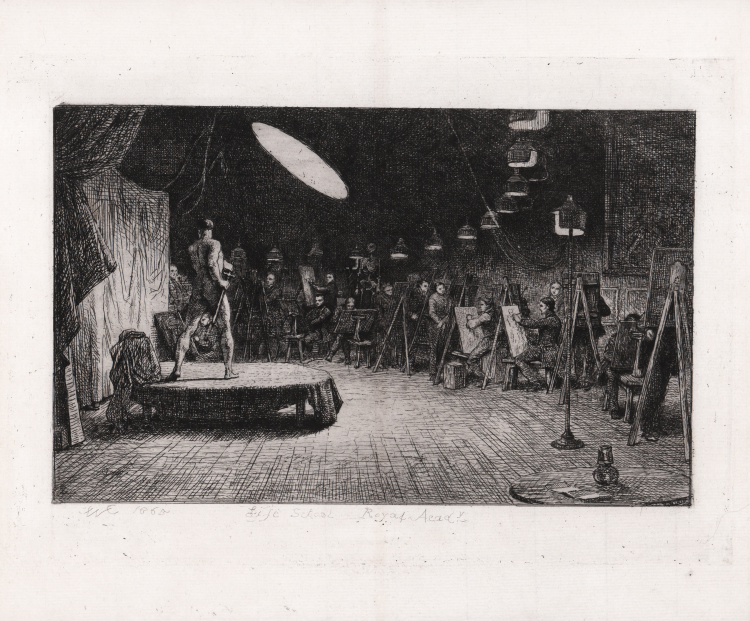



| Reference: | S42307 |
| Author | Charles West COPE |
| Year: | 1865 |
| Measures: | 270 x 200 mm |


| Reference: | S42307 |
| Author | Charles West COPE |
| Year: | 1865 |
| Measures: | 270 x 200 mm |
Life School Royal Academy, 1865, published in 1868 by Philip Gilbert Hamerton (1834–1894) in Etching and Etchers.
Etching and drypoint on laid paper with (flattened) centrefold and full margins.
Inscribed on plate below the image borderline: (left) "CWC 1865"; (centre) "Life School Royal Acady"
Interior of the life school of the Royal Academy: artists in a curved line, under lamps, drawing at easels, from a model on a low round dias under a large lamp, with a drape and curtain on the left, standing with one leg in front of the other and drawing a sword.
This etching of a 19th century life class with a nude figure as a model at the Royal Academy is one of the most famous images of such a class. Its fame is partly because the portrayed scene is a strong and memorable composition with the curved arrangement of easels and overhead lights illuminating the nude model. Beyond the visually arresting theatricality of the scene, however, the image is also a rare and valuable historical document of how life classes were organised.
Charles West Cope RA (28 July 1811, in Leeds – 21 August 1890, in Bournemouth) was an English, Victorian era painter of genre and history scenes, and an etcher. He was responsible for painting several frescos in the House of Lords in London. Cope founded an artists' society called 'The Etching Club' which included artists such as William Holman Hunt, Richard Redgrave and Samuel Palmer. The club published several books of etchings illustrating various themes by well-known authors.
|
Charles West Cope RA (28 July 1811, in Leeds – 21 August 1890, in Bournemouth) was an English, Victorian era painter of genre and history scenes, and an etcher. He was responsible for painting several frescos in the House of Lords in London. Cope was born at Park Square in Leeds, the son of Charles Cope, a watercolour landscape painter and art teacher. In the 1828 Cope became a student of the Royal Academy. In 1832 Cope went to Paris and practiced his art by copying Old Masters at the Louvre such as Titian, Rembrandt and others. In 1833 he exhibited at the Royal Academy for the first time – a picture called The Golden Age. In September of the same year he travelled to Italy, where he spent two years – earning a living for part of the time by painting pictures on commission. Cope founded an artists' society called 'The Etching Club' which included artists such as William Holman Hunt, Richard Redgrave and Samuel Palmer. The club published several books of etchings illustrating various themes by well-known authors.
|
|
Charles West Cope RA (28 July 1811, in Leeds – 21 August 1890, in Bournemouth) was an English, Victorian era painter of genre and history scenes, and an etcher. He was responsible for painting several frescos in the House of Lords in London. Cope was born at Park Square in Leeds, the son of Charles Cope, a watercolour landscape painter and art teacher. In the 1828 Cope became a student of the Royal Academy. In 1832 Cope went to Paris and practiced his art by copying Old Masters at the Louvre such as Titian, Rembrandt and others. In 1833 he exhibited at the Royal Academy for the first time – a picture called The Golden Age. In September of the same year he travelled to Italy, where he spent two years – earning a living for part of the time by painting pictures on commission. Cope founded an artists' society called 'The Etching Club' which included artists such as William Holman Hunt, Richard Redgrave and Samuel Palmer. The club published several books of etchings illustrating various themes by well-known authors.
|